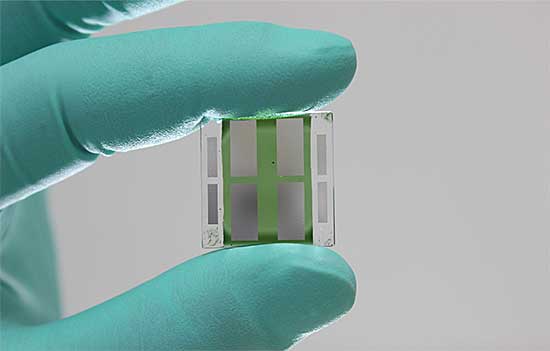
Organic photovoltaic solar cells (OPV) such as polymer solar cells are promising but not quite ready for commercial production. Their significantly lower device efficiency and operational lifetime compared with conventional silicon cells posed challenges for mass production.
Continuous Innovation at Heliatek
Nevertheless, researchers continue to work out improvements on the basic OPV design, undeterred by the efficiency and lifetime issues of the OPV. German solar technology firm Heliatek did not stop innovating OPV for its solar-powered car despite the discouraging 3% efficiency of the OPV that time, around 2003.
In 2012, the German company claimed world-record of 10.7% conversion efficiency for its OPV, and promised to reach the 15% to 20% efficiency of inorganic solar cells. A year after, Optics Org reported that Heliatek had “pushed the conversion efficiency of its organic photovoltaic (OPV) cells to 12%,” which is equivalent to at least 15% in conventional semiconductor-based cells.
Fast forward to 2016, three years after, the German solar technology company announced a new record of 13.2% conversion efficiency using a multi-junction cell. OPV are gaining more interest in the realm of green energy technology because they are cheaper to produce and are more flexible.
Heliatek further claimed that its latest OPV with 13.2% efficiency exhibit “excellent low light and high temperature behavior” of its inorganic counterpart and can generate power as well as conventional cells with 16% efficiency under real world conditions.
Purdue University Research Findings
Much like Heliatek, the engineering professors of Purdue University are conducting a research suggesting a new method for manufacturing inexpensive solar technology.
Researchers, Muhammad Ashraful Alam, Bryan Boudourism, Biswajit Ray, Aditya Baradwaj and Ryyan Khan suggested to keep electron-hole pairs separated so that they don’t recombine and impede current generation. They also suggested to simplify the design of organic solar cells using only one type of polymer, and to produce cells out of purer polymers since they are more efficient.
The US Department of Energy, and the US Air Force are some of the sponsors to the research.
Likely Commercialization of OPV
In its latest OPV design, Heliatek combined three kinds of absorbers specifically dedicated to convert green, red and near-infrared light to electricity with more efficiency than ever before. It has only been 13 years since OPV was met with much skepticism, but Heliatek’s new world-record solar cells may just well be the key to cost-effective harnessing and harvesting of sunlight to make electricity.
Heliatek’s super lightweight, flexible and low-cost organic solar cells provides a hint that commercialization of OPV may well be under way. Organic solar cells offer a substantial cost advantage over silicon solar cells, and may be manufactured via roll-to-roll processing like that of newspaper printing.
In the same way, Purdue University researchers are continuing on the study and are working on a new type of solar cells that don’t need bulk heterojunctions. They intend to dig deeper into how OPV operate and to help design more efficient and more affordable organic solar cells.